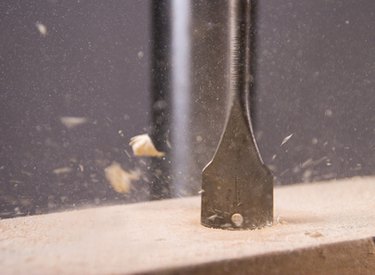
The drill press was invented for use in cutting metal, but it didn't take long for woodworkers to discover the advantages of a drill press. A single drill press could be used for making precision holes repeatedly, allowing for one person operating the drill to perform the same amount of work that used to take many people. Drill presses can be adjusted to drill at almost any angle, and at a variety of speeds.
Drills
Video of the Day
The first hand-operated electric drill was invented in Melbourne, Australia, in 1889. Prior to that time, most drilling was accomplished using hand-crank drills for small bores, and larger brace-style drills when more torque was required. The first drill turned in a clockwise motion only (from the operator's perspective), a feature that most drill presses still employ today. Many years later, a reverse feature was added to hand drills.
Video of the Day
Early Drill Presses
The first drill presses, which appeared in smithy shops and machine shops more than 200 years ago, were built for cutting metal and were powered by a hand crank. The precision of the stationary drill press was advantageous to factory machinists and blacksmiths, as it allowed them to make repeatable cuts with heretofore unmatched accuracy. Even without electric power, these wall-mounted drill presses were much faster and more accurate than hand-operated electric drills.
Feed Options
The first drill presses used a feed arm with a wheel to drive the spinning drill bit through the wood. To remove the bit from the wood, the wheel needed to be backed out. Later models employed a lever-operated, dual-feed mechanism that allowed for quicker removal of the bit, making the start-to-finish drill operation much faster.
Electric Motor
The first electric drill presses were built in the 1920s and incorporated such features as a larger chuck to hold various bits securely, a plunging bit mechanism and an adjustable-height work table. The combination of these innovations allowed drill presses to become much larger floor standing models, some of which are still in use today.
Modern Features
Today's drill presses use a variety of technologically advanced features: electronic variable speed motors, step pulleys for greater speed ranges, keyed chucks and more. Many of these units include features carried over from other tools, such as a T-track miter slot from a table saw, that can be used to mount vises, clamping blocks and hold-downs. Some drill presses even have add-ons such as a mortising attachment, that allows the operator to cut square holes for mortises.